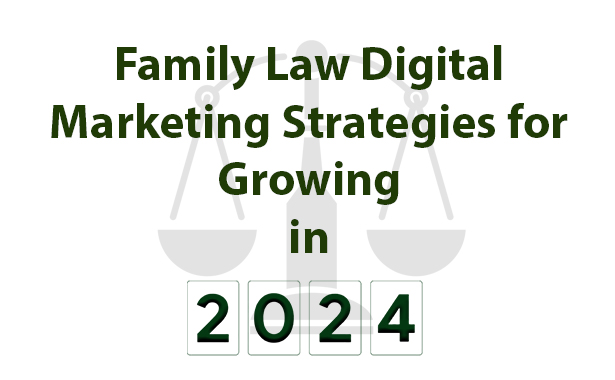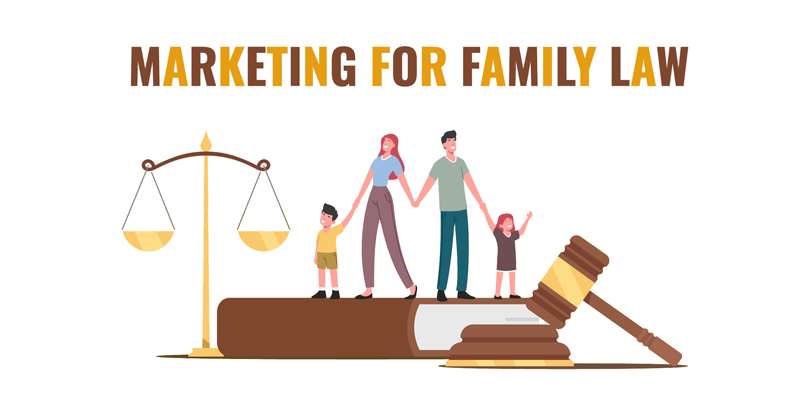Contents
Introduction
In the fast-evolving landscape of legal services, family law firms are recognizing the critical role of digital marketing in reaching and connecting with their target audience. In an era where the internet dominates how information is sought and shared, the need for a robust digital marketing strategy cannot be overstated. This introduction sheds light on the transformative power of digital marketing for family law firms, emphasizing its relevance and impact in the current internet-centric world.
Evolving Landscape: The legal industry, including family law, is experiencing a paradigm shift with the increasing prevalence of digital technologies. Clients now turn to the internet to seek legal advice, research attorneys, and understand their rights. The introduction highlights how this shift necessitates a corresponding transformation in marketing strategies.
Importance of Digital Marketing: In a world where online visibility can be the key to success, family law firms must recognize the Significance of Digital Marketing. Whether it’s building brand awareness, attracting new clients, or retaining existing ones, a well-crafted digital marketing strategy is foundational to staying competitive in the legal landscape.
Internet-Centric World: The introduction emphasizes the centrality of the internet in people’s lives today. Potential clients are more likely to discover and engage with legal services online, making digital marketing an indispensable tool for family law firms looking to expand their reach and thrive in the modern legal marketplace.
As we delve into the subsequent sections, we will explore specific strategies that family law firms can adopt to not only navigate but excel in the digital realm, ensuring that they remain at the forefront of their clients’ minds when legal needs arise. From setting SMART goals to leveraging cutting-edge technologies, this blog will provide actionable insights to propel family law firms into a new era of digital marketing excellence.
Setting Goals and Defining a Marketing Budget
In the dynamic realm of family law digital marketing, success hinges on setting clear and achievable goals while navigating a well-defined budget. This section delves into the pivotal aspects of goal setting and budget allocation, highlighting the importance of a strategic approach.
- Importance of SMART Goals: Family law firms must establish Specific, Measurable, Achievable, Relevant, and Time-bound (SMART) goals. This involves defining precise objectives that are quantifiable and aligned with the firm’s overall vision. SMART goals provide a roadmap, allowing marketing efforts to be focused, measurable, and conducive to long-term success.
- Allocating Budget Effectively: While setting ambitious goals is crucial, the means to achieve them are equally important. This section emphasizes the necessity of allocating the marketing budget effectively to maximize impact. Whether family law firms invest in Search Engine Optimization (SEO), social media advertising, or content creation, a well-balanced budget ensures a comprehensive and sustainable digital marketing strategy.
- Data-Driven Decision Making: Encouraging family law firms to adopt a data-driven approach, the section underscores the significance of analyzing the performance of various marketing channels. By leveraging analytics and key performance indicators (KPIs), firms can refine their strategies, allocating resources where they yield the highest returns.
- Adaptability and Flexibility: In the ever-changing landscape of digital marketing, adaptability is key. The section emphasizes the need for family law firms to stay agile, adjusting goals and budgets based on evolving market trends and emerging opportunities.
As family law firms embark on their digital marketing journey, setting SMART goals and establishing a well-considered budget lay the foundation for a strategic and impactful campaign. The subsequent sections will delve into specific strategies, from understanding target audiences to optimizing websites and embracing multimedia content, providing a comprehensive guide for family law firms to thrive in the digital age.
Read more: The Importance of Accurate Data Entry for Law Firms
Identifying Your Target Audience
In the expansive digital space, understanding and connecting with your target audience is paramount for effective family law digital marketing. This section delves into the intricacies of identifying your ideal clients and creating client personas to tailor marketing strategies for maximum impact.
- Necessity of Understanding Your Ideal Clients: Family law firms need a deep understanding of their target audience to tailor their marketing efforts effectively. This involves not only recognizing the demographics of potential clients but also understanding their pain points, motivations, and the specific legal services they seek. This section emphasizes the significance of aligning marketing strategies with the needs and preferences of the target audience.
- Tailoring Content and Messaging: Armed with insights from client personas, family law firms can tailor their content and messaging to resonate with specific segments of their audience. Whether it’s addressing concerns related to divorce, child custody, or other family law matters, personalized communication enhances engagement and builds a stronger connection with potential clients.
- Tailoring Content and Messaging: Armed with insights from client personas, family law firms can tailor their content and messaging to resonate with specific segments of their audience. Whether it’s addressing concerns related to divorce, child custody, or other family law matters, personalized communication enhances engagement and builds a stronger connection with potential clients.
- Dynamic Nature of Audience Identification: The section acknowledges that the identification of the target audience is not a one-time task. It emphasizes the importance of regularly revisiting and updating client personas to stay aligned with evolving market trends, societal changes, and shifts in client preferences.
By honing in on the needs and characteristics of their target audience, family law firms can fine-tune their digital marketing strategies, ensuring that every piece of content and every marketing campaign resonates effectively with those who matter most. The subsequent sections will delve into crafting compelling value propositions, optimizing websites for user experience, and leveraging gated content for lead generation, providing a holistic approach to family law digital marketing.
Crafting a Strong Value Proposition
In the highly competitive landscape of family law, a compelling value proposition serves as the cornerstone of successful digital marketing. This section explores the art of crafting a strong value proposition that not only distinguishes a family law firm from its competitors but also resonates deeply with the needs and aspirations of potential clients.
- Developing a Compelling Value Proposition: A value proposition is more than a tagline; it’s a succinct statement that communicates the unique benefits a family law firm offers to its clients. This section guides family law firms in developing a value proposition that encapsulates their core strengths, distinct services, and the exceptional value they provide to clients navigating sensitive legal matters.
- Standing Out in the Competitive Market: Emphasis is placed on the need for family law firms to identify what sets them apart. Whether it’s a specialized area of expertise, a unique approach to client relationships, or innovative legal solutions, a well-crafted value proposition positions the firm as a standout choice in the competitive family law landscape.
- Highlighting Unique Legal Services and Client Experiences: Beyond generic legal services, the section encourages family law firms to spotlight the distinctive aspects of their practice. This could include innovative approaches to mediation, collaborative law, or personalized client experiences that set them apart from conventional law firms.
- Aligning with Client Needs: A strong value proposition is one that resonates with the specific needs and concerns of potential clients. By aligning the value proposition with the pain points and aspirations of individuals seeking family law services, firms can forge a deeper connection and instill confidence in their ability to address unique legal challenges.
As family law firms articulate a compelling value proposition, they lay the foundation for building brand loyalty and attracting clients who align with their core values. The subsequent sections will delve into optimizing websites for a seamless user experience, effectively using gated content for Lead Generation, and showcasing legal expertise and credibility online through testimonials and success stories.
Optimizing Website for User Experience and Lead Generation
In the digital age, a family law firm’s website is often the first point of contact between the firm and potential clients. This section underscores the importance of optimizing the website for an exceptional user experience and leveraging it as a powerful tool for lead generation.
- Implementing a Mobile-First Design for Better Engagement: With a significant portion of internet users accessing content through mobile devices, family law firms must prioritize a mobile-first design. This involves creating a website that is not only visually appealing on smartphones and tablets but also ensures seamless navigation and functionality across different devices. The section emphasizes that a responsive design enhances user engagement and positively impacts search engine rankings.
- Incorporating Features Like Live Chat for Immediacy and Connectivity: To enhance user experience, family law firms can integrate features like live chat on their websites. This facilitates real-time communication, allowing potential clients to seek immediate information and assistance. The section highlights how live chat enhances connectivity, providing a convenient channel for inquiries and establishing a direct line of communication.
- Intuitive Navigation and Clear Calls to Action: A user-friendly website is characterized by intuitive navigation and clear calls to action. Potential clients should easily find the information they are seeking, and the website should guide them seamlessly through the desired actions, such as contacting the firm, scheduling a consultation, or accessing informative resources. This section stresses the importance of simplifying the user journey for maximum effectiveness.
- Optimizing Landing Pages for Conversion: Landing pages play a crucial role in converting website visitors into leads. This section delves into the principles of creating compelling landing pages, emphasizing concise and persuasive content, strategically placed calls to action, and forms that capture essential lead information. By optimizing landing pages, family law firms maximize their chances of converting website traffic into actionable leads.
As family law firms optimize their websites for user experience and lead generation, they create a digital hub that not only serves as a virtual storefront but also actively contributes to the growth and success of the practice. The subsequent sections will explore the effective use of gated content for lead generation, strategies to showcase legal expertise and credibility online, and the crucial role of SEO in family law digital marketing.
Effective Use of Gated Content
In the realm of family law digital marketing, Gated Content emerges as a potent strategy for generating leads and cultivating a relationship of trust with potential clients. This section explores the concept of gated content, providing insights into its effective use and highlighting how family law firms can leverage this strategy to enhance their Online Presence.
Leveraging Gated Content to Generate Leads: Gated content involves offering valuable resources such as ebooks, whitepapers, or exclusive guides in exchange for the visitor’s contact information. This section underscores the significance of creating high-quality, informative content that addresses the specific concerns and questions of potential clients. By placing this content behind a virtual gate, family law firms can capture leads and build a database of individuals interested in their services.
RunSensible’s Lead Generation Tool: Introducing RunSensible’s lead generation tool, this section emphasizes how family law firms can take advantage of advanced technologies to streamline the process of capturing and managing leads. RunSensible’s tool can be seamlessly integrated into the website, offering a user-friendly experience for both the firm and potential clients.
Creating Valuable Resources to Enhance Reputation and Attract Visitors: Gated content should not only serve as a lead magnet but also contribute to the firm’s reputation as a trusted authority in family law. By creating comprehensive resources that address common legal issues, offer actionable advice, and showcase the firm’s expertise, family law practices can attract a broader audience and position themselves as valuable resources in the digital space.
Strategic Placement and Promotion: The section explores the strategic placement and promotion of gated content across different digital channels. Whether through targeted social media campaigns, email marketing, or prominently featured on the website, effective promotion ensures that the gated content reaches the right audience and maximizes lead generation potential.
As family law firms harness the power of gated content, they not only generate leads but also establish themselves as authoritative sources within the legal landscape. The subsequent sections will delve into strategies for showcasing legal expertise and credibility online, the importance of SEO in family law digital marketing, and the nuances of local search optimization for community-based targeting.
Showcasing Legal Expertise and Credibility Online
In the digital era, establishing trust and credibility is paramount for family law firms seeking to attract and retain clients. This section explores strategic approaches to showcase legal expertise and build credibility online, leveraging testimonials, case studies, and success stories.
Strategies to Demonstrate Legal Capability
Family law firms must proactively showcase their legal expertise to instill confidence in potential clients. This involves presenting a comprehensive overview of the firm’s practice areas, attorneys’ credentials, and any specializations. The section emphasizes the importance of transparently communicating the firm’s capabilities to align with the diverse needs of clients seeking family law services.
Utilizing Testimonials
Testimonials from satisfied clients serve as powerful endorsements of a family law firm’s competence and client-centric approach. The section guides firms on soliciting and showcasing testimonials strategically on their website. Genuine and compelling testimonials offer social proof, helping potential clients build trust in the firm’s ability to navigate complex legal matters.
Presenting Case Studies and Success Stories
In-depth case studies and success stories provide a narrative that illustrates the firm’s successful resolutions of complex legal challenges. This section encourages family law firms to present detailed accounts of past cases, highlighting their expertise in achieving positive outcomes for clients. These stories offer valuable insights into the firm’s problem-solving capabilities and client-focused approach.
Interactive Content Elements
Incorporating interactive content elements, such as video testimonials or Q&A sessions with attorneys, adds a dynamic dimension to showcasing legal expertise. This approach enhances engagement and allows potential clients to connect with the human side of the legal professionals, fostering a sense of familiarity and trust.
As family law firms strategically showcase their legal expertise and credibility online, they build a strong foundation for client trust. The subsequent sections will delve into the importance of SEO in family law digital marketing, strategies for local search optimization to target community-based clients, and the adoption of multimedia content creation to diversify the firm’s online presence.
Maximizing Visibility with SEO
In the expansive digital landscape, the visibility of a family law firm is intricately tied to its search engine ranking. This section underscores the paramount importance of Search Engine Optimization (SEO) in family law digital marketing, offering insights into optimizing content, enhancing online presence, and ensuring the firm appears prominently in relevant search results.
- Importance of SEO in Family Law Digital Marketing
- Building Content Around the Right Keywords
- Optimizing for On-Page SEO
- Strategic Use of Backlinks and Internal Links
By adopting a strategic and comprehensive SEO approach, family law firms can position themselves for sustained online visibility, ensuring that potential clients readily find them when seeking legal services. The subsequent sections will delve into the nuances of local search optimization for community-based targeting, the role of Google Business Profile optimization for local visibility, and the integration of multimedia content creation to diversify the firm’s online presence.
Local Search Optimization
Recognizing the localized nature of family law services, this section explores the nuances of Local Search Optimization—a crucial strategy for family law firms aiming to target clients within specific geographic areas. By tailoring digital marketing efforts to a local audience, firms can significantly enhance their visibility and relevance.
Utilizing Local SEO to Target Community-Based Clients: Local Search Optimization involves optimizing online assets to attract local clients actively seeking family law services. This section emphasizes the need for family law firms to leverage location-based keywords, create localized content, and ensure consistent business information across online platforms. This approach ensures that the firm appears prominently in local search results, connecting with individuals in the community seeking legal assistance.
Importance of Google Business Profile Optimization for Local Visibility: A cornerstone of local search optimization is optimizing the Google Business Profile. This section provides actionable insights into enhancing the firm’s visibility on Google Maps, encouraging positive reviews, and ensuring accurate business information. An optimized Google Business Profile not only improves local search rankings but also establishes trust among potential clients.
Nurturing Community Relationships: Beyond online strategies, family law firms should actively engage with the local community. Participation in local events, sponsorship of community initiatives, and collaboration with local organizations can foster positive relationships. Such activities contribute not only to community goodwill but also to word-of-mouth referrals, a powerful driver of local business.
Localized Content Strategies: Creating content that resonates with the local audience is key to successful local search optimization. This section explores strategies for producing content that addresses region-specific legal concerns, local regulations, and community news. By tailoring content to the unique needs of the local community, family law firms can establish themselves as trusted advisors in the area.
As family law firms embrace Local Search Optimization, they position themselves as community-centric legal resources, creating a powerful connection with potential clients in their vicinity. The subsequent sections will delve into the diversification of the firm’s online presence through multimedia content creation, emphasizing the importance of becoming a content king by using diverse media formats.
Embracing Multimedia Content Creation
In a digital landscape where diverse content formats captivate audiences, family law firms can elevate their online presence by embracing multimedia content creation. This section explores the benefits of adopting a varied content strategy, including the use of FAQs, videos, and infographics to engage audiences effectively
1. Becoming a Content King by Using Diverse Media Formats
This section underscores the importance of diversifying content creation to cater to different preferences and learning styles. By expanding beyond traditional written content, family law firms can enhance engagement, reach a broader audience, and establish themselves as authoritative figures in the legal space.
2. Creating a Rich Content Mix Including FAQs
Frequently Asked Questions (FAQs) provide a valuable opportunity for family law firms to address common queries and concerns. Incorporating FAQs into the website helps potential clients find relevant information quickly. This section guides firms on creating comprehensive FAQ sections, covering topics ranging from divorce procedures to child custody laws.
3. Leveraging Videos for Engaging Content
Videos offer a dynamic and visually compelling way to communicate information. This section explores the benefits of incorporating videos into the digital marketing strategy of family law firms. Whether through informational videos, client testimonials, or live-streamed Q&A sessions, video content adds a personal touch and fosters a stronger connection with the audience.
4. Infographics for Visual Storytelling
Infographics distill complex information into visually appealing and easily digestible formats. This section discusses the strategic use of infographics in family law digital marketing, allowing firms to convey legal processes, statistics, and other information in a visually compelling manner. Infographics are highly shareable and can amplify the firm’s reach across social media platforms.
5. Accessibility and Inclusivity
Multimedia content enhances accessibility and inclusivity by catering to individuals with different learning preferences. Whether someone prefers reading text, watching videos, or quickly scanning infographics, offering content in diverse formats ensures that the firm’s message reaches a broader and more diverse audience.
By embracing multimedia content creation, family law firms not only enrich their online presence but also adapt to the evolving preferences of digital audiences. The subsequent sections will conclude the comprehensive guide by recapping the importance of digital marketing in the family law field, encouraging the adoption of the discussed strategies for market dominance, and providing a call to action for family law firms to leverage RunSensible’s legal case management software and CRM solutions for enhanced digital marketing efforts.
Conclusion
As family law firms navigate the complexities of the digital landscape, the strategies outlined in this comprehensive guide pave the way for sustained growth and success.
By adopting a holistic approach to digital marketing, family law firms can establish a strong and enduring presence in the online sphere, reaching and resonating with the clients they aim to serve. The guide has provided a roadmap for success, and the call to action encourages firms to not only embrace these strategies but to leverage cutting-edge tools like RunSensible to amplify their impact.
As family law continues to evolve, those at the forefront of digital marketing innovation are poised to thrive in this dynamic landscape. With a commitment to excellence and an embrace of the strategies outlined in this guide, family law firms can confidently navigate the digital future and secure lasting success in the competitive legal arena.
FAQs
1. Why is digital marketing crucial for family law firms?
Digital marketing is essential for family law firms in today’s internet-centric world because it allows them to reach and engage with their target audience effectively. Potential clients increasingly turn to online platforms to seek legal services and information. A robust digital marketing strategy enhances a firm’s visibility, builds trust, and ensures a competitive edge in the digital landscape.
2. How can I optimize my family law firm’s website for user experience?
Optimizing your website for user experience involves implementing a mobile-first design, incorporating features like live chat for immediate interaction, ensuring intuitive navigation, and strategically placing calls to action. The goal is to create a seamless and engaging experience for visitors, making it easy for them to find information and take desired actions.
3. How can RunSensible’s legal case management software help family law firms with digital marketing?
RunSensible’s legal case management software and CRM solutions aid family law firms in running targeted email campaigns, generating leads, and efficiently tracking prospects and clients. These tools streamline digital marketing efforts, contributing to a more organized and effective client management process.
Disclaimer: The content provided on this blog is for informational purposes only and does not constitute legal, financial, or professional advice.








